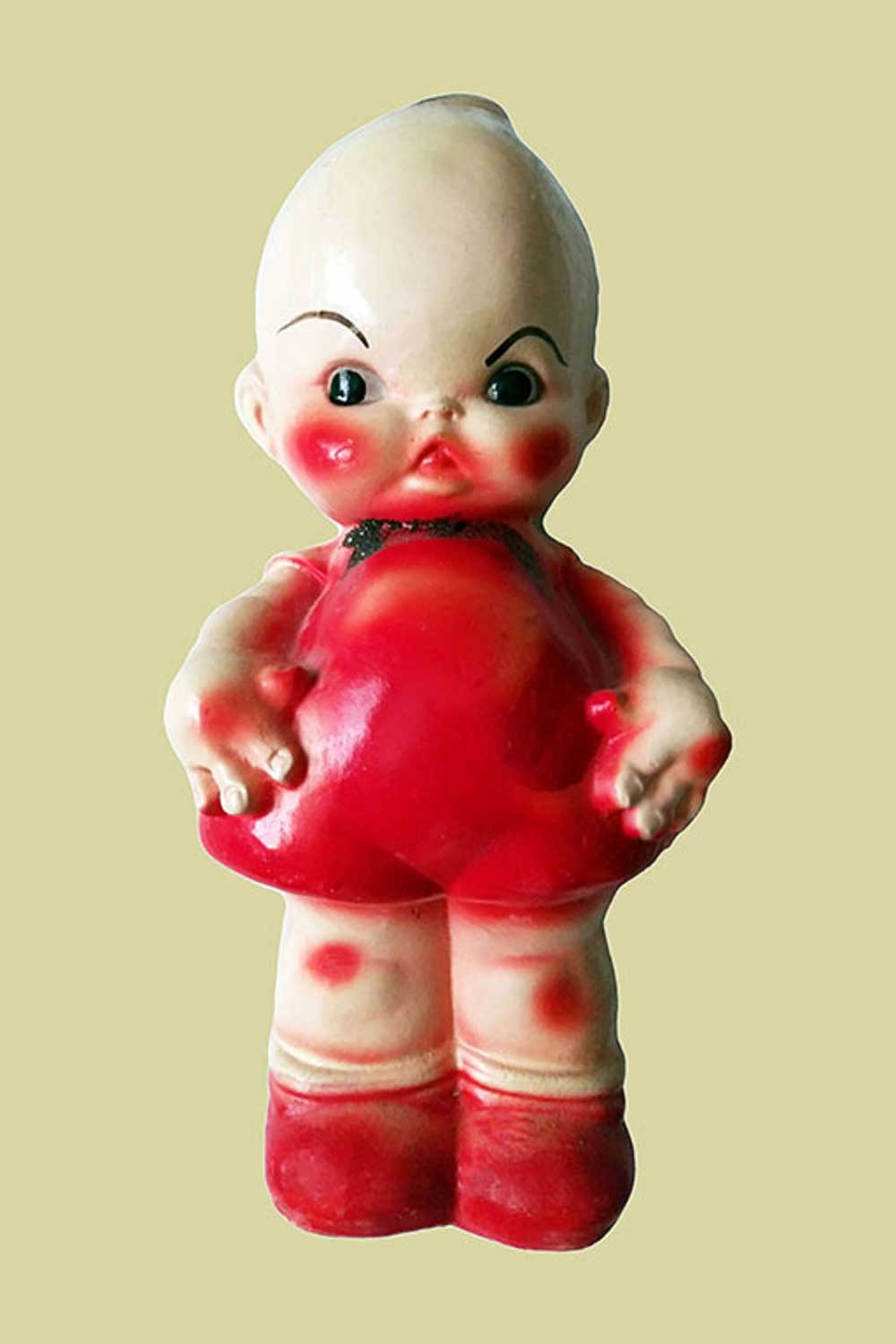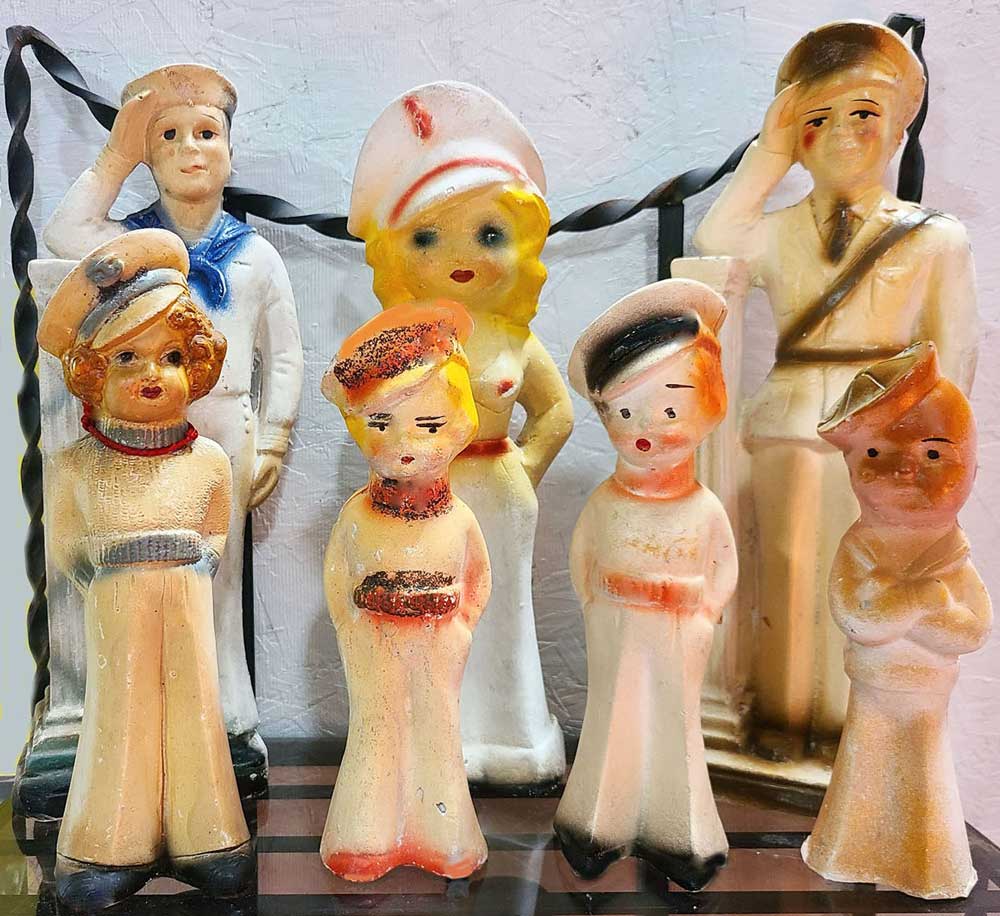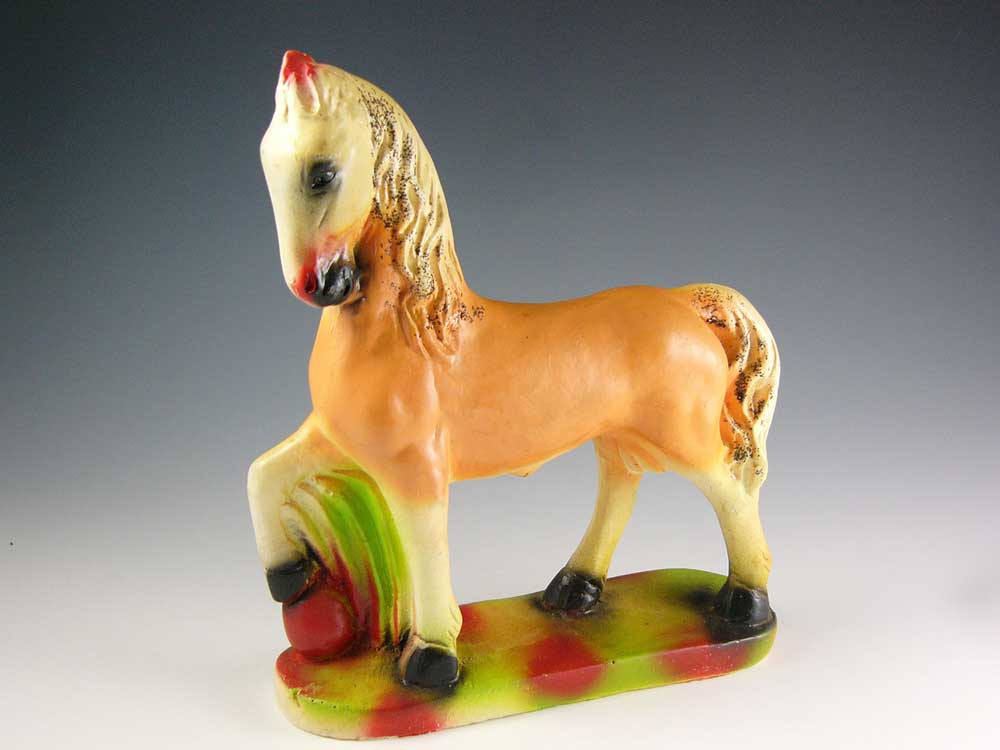August 2023
SMACK DAB IN THE MIDDLE
Chalk Talk: Collecting Carnival Chalkware
by Donald-Brian Johnson
“Hey there, fella! Step right up and take yer chance! Knock down the milk bottles, and win a kewpie for your girlie! All it takes is one thin dime!”
Lines like that have been circulating around carnivals for years… and over those years, lots of fellas have been falling for it. Usually, it took plenty more than “one thin dime” to knock over those bottles, but eventually, down they went. The determined, now dimeless, player (or more likely, his “girlie”), proceeded merrily down the midway, the proud possessor of a chalk-ware “kewpie doll.”
While oversized stuffed animals rule the fairground roost today, it wasn’t always so. During the heyday of traveling carnivals, from the Depression years of the 1930s well into the 1950s, chalkware figurines were the sought-after prizes in games of chance. Originally called “kewpie dolls,” after the Rose O’Neil impish bald-headed cherubs which populated their ranks, chalkware characters actually came in many guises. There were quaint animals, from piggy bank pigs to pipe-smoking chimps … jolly clowns and seductive “sweater girls”… patriotic portrayals of George Washington and Native Americans… plus pop-culture favorites, ranging from the Lone Ranger to the Easter Bunny.
Carnival-goers loved chalkware figurines because they were colorful and fun. Carnival operators loved them because they were inexpensive: a 1940 catalog, from novelty supplier Gellman Bros. of Minneapolis, listed a ‘Popeye” chalk lookalike for 13 cents (or just a few pennies over that “one thin dime”).
Before wending its way to the midway, chalkware had occupied a loftier spot. Dur-ing the 1800s and early 1900s, there were those who admired Staffordshire por-celain figurines, but were unable to afford them. Staffordshire-like chalk reproductions of elegant couples and docile animals proved an acceptable substitute. And, since chalk-ware was essentially molded plaster of Paris, cold-painted in watercolors or oils, the results fit almost every budget (Today, those early figurines, attributed to the Pennsylvania Dutch, are as sought-after as their porcelain predecessors).

Chalkware Kewpie Doll
You can call her “Kewpie,” but according to the Gellman Bros. catalog she’s the “Snookie Doll.” (Image courtesy of the author and Hank Kuhlmann)

Chalkware Figurines
Parade rest: a lineup of chalkware figurines in patriotic attire. (Image courtesy of the author and Hank Kuhlmann)
Carnival chalkware occupied a less heady pla-teau. Representations of familiar personages, ani-mals, and things (like autos or sailing ships), were what the customer wanted, pre-ferably when those familiar faces were decked out in bright, eye-catching colors, with the occasional splash of glitter. Potential prize-winners were agog: “Look – there’s Rin Tin Tin! And Pinocchio! And over there are Charlie McCarthy and Snow White!” Licensing big names was never a problem for novelty suppliers. The figures may have looked exactly like their name-sakes, but company catalogs would have you believe differently. According to Gellman Bros., Rinty was “Rex the Police Dog,” Pinocchio was the “Comical Puppet,” Charlie McCarthy was “Talkie Dan,” and Snow White was “Miss Wonderland.” Even the Kewpie cherub was reborn as the “Snookie Doll.” Regardless of the name, customers knew what they were winning, and proprietors knew that they knew; the lack of licensing fees kept prices affordable.
Chalkware figurines came in a variety of sizes: “small” (5-8”); “medium” (8-10”); and “large” (11-18”). (The better the game player, the bigger the prize!). Some, like Charlie McCarthy, were produced in assorted sizes and colors. Prices for most figures remain remarkably low, starting at around $10 for those in not-so-nifty condition, up into the low hundreds for rarer figures. Also available, besides piggy banks: chalkware string dispensers, bookends, lamps, wall plaques, “nodders,” and even Christ-mas decorations.
A chalkware drawback is its fragility. Since it’s plaster, it chips. Since it’s cold-painted without glaz-ing, it fades. Chalkware can’t be washed, unless you want to remove even more color. So, collectors in search of mint chalkware figurines may need to resign themselves to a few (or, in the case of a hard-to-find piece, more than a few), imperfections.
But for chalkware connoisseurs, love is blind. Stocking your shelves with chalkware figures, even if in less-than-ideal condition, can summon up happy memories of bygone days. Best of all, you don’t have to knock over any milk bottles to get them.

Chalkware Horse
Glitter accents on mane and tail add to the appeal of this chalkware horse. (Image courtesy of the author and Hank Kuhlmann)
Donald-Brian Johnson is the co-author of numerous Schiffer books on design and collectibles, including “Postwar Pop,” a collection of his columns. Please address inquiries to: donaldbrian@msn.com

